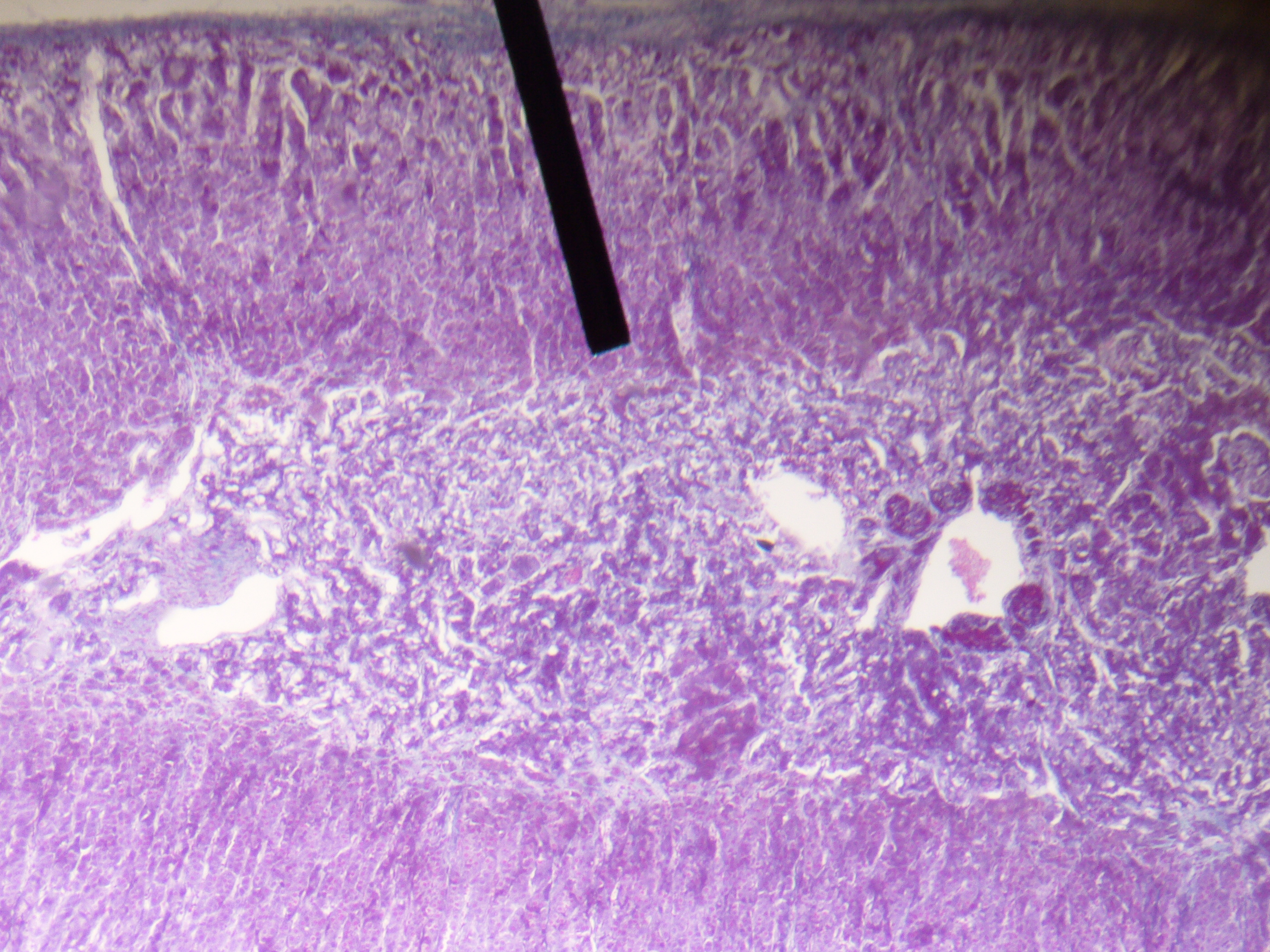Zona reticularis on:
[Wikipedia]
[Google]
[Amazon]
The zona reticularis (sometimes, reticulate zone) is the innermost layer of the 
adrenal cortex
The adrenal cortex is the outer region and also the largest part of an adrenal gland. It is divided into three separate zones: zona glomerulosa, zona fasciculata and zona reticularis. Each zone is responsible for producing specific hormones. It is ...
, lying deep to the zona fasciculata
The ''zona fasciculata'' (sometimes, fascicular or fasciculate zone) constitutes the middle and also the widest zone of the adrenal cortex, sitting directly beneath the ''zona glomerulosa''. Constituent cells are organized into bundles or "fascicl ...
and superficial to the adrenal medulla
The adrenal medulla ( la, medulla glandulae suprarenalis) is part of the adrenal gland. It is located at the center of the gland, being surrounded by the adrenal cortex. It is the innermost part of the adrenal gland, consisting of chromaffin cel ...
. The cells are arranged cords that project in different directions giving a net-like appearance (L. reticulum - net).
Cells in the zona reticularis produce precursor androgens
An androgen (from Greek ''andr-'', the stem of the word meaning "man") is any natural or synthetic steroid hormone that regulates the development and maintenance of male characteristics in vertebrates by binding to androgen receptors. This inc ...
including dehydroepiandrosterone
Dehydroepiandrosterone (DHEA), also known as androstenolone, is an endogenous steroid hormone precursor. It is one of the most abundant circulating steroids in humans. DHEA is produced in the adrenal glands, the gonads, and the brain. It functio ...
(DHEA) and androstenedione
Androstenedione, or 4-androstenedione (abbreviated as A4 or Δ4-dione), also known as androst-4-ene-3,17-dione, is an endogenous weak androgen steroid hormone and intermediate in the biosynthesis of estrone and of testosterone from dehydroepia ...
from cholesterol
Cholesterol is any of a class of certain organic molecules called lipids. It is a sterol (or modified steroid), a type of lipid. Cholesterol is biosynthesized by all animal cells and is an essential structural component of animal cell mem ...
. DHEA is further converted to DHEA-sulfate via a sulfotransferase
Sulfotransferases (SULTs) are transferase enzymes that catalyze the transfer of a sulfo group from a donor molecule to an acceptor alcohol or amine. The most common sulfo group donor is 3'-phosphoadenosine-5'-phosphosulfate (PAPS). In the case o ...
, SULT2A1
Bile salt sulfotransferase also known as hydroxysteroid sulfotransferase (HST) or sulfotransferase 2A1 (ST2A1) is an enzyme that in humans is encoded by the ''SULT2A1'' gene.
Function
Sulfotransferase enzymes catalyze the sulfate conjugation ...
. These precursors are not further converted in the adrenal cortex if the cells lack 17β-Hydroxysteroid dehydrogenase. Instead, they are released into the blood stream and taken up in the testis
A testicle or testis (plural testes) is the male reproductive gland or gonad in all bilaterians, including humans. It is homologous to the female ovary. The functions of the testes are to produce both sperm and androgens, primarily testostero ...
and ovaries
The ovary is an organ in the female reproductive system that produces an ovum. When released, this travels down the fallopian tube into the uterus, where it may become fertilized by a sperm. There is an ovary () found on each side of the body. T ...
to produce testosterone
Testosterone is the primary sex hormone and anabolic steroid in males. In humans, testosterone plays a key role in the development of Male reproductive system, male reproductive tissues such as testes and prostate, as well as promoting secondar ...
and the estrogens
Estrogen or oestrogen is a category of sex hormone responsible for the development and regulation of the female reproductive system and secondary sex characteristics. There are three major endogenous estrogens that have estrogenic hormonal acti ...
respectively.
ACTH
Adrenocorticotropic hormone (ACTH; also adrenocorticotropin, corticotropin) is a polypeptide tropic hormone produced by and secreted by the anterior pituitary gland. It is also used as a medication and diagnostic agent. ACTH is an important co ...
partially regulates adrenal
The adrenal glands (also known as suprarenal glands) are endocrine glands that produce a variety of hormones including adrenaline and the steroids aldosterone and cortisol. They are found above the kidneys. Each gland has an outer cortex which ...
androgen
An androgen (from Greek ''andr-'', the stem of the word meaning "man") is any natural or synthetic steroid hormone that regulates the development and maintenance of male characteristics in vertebrates by binding to androgen receptors. This inc ...
secretion, also CRH CRH may refer to:
* Calibre radius head, a traditional British ordnance term for a concept in ballistic projectile design
* Celtic Resources Holdings, an Irish mining company
* China Railway High-speed, a high-speed railway service operated by Chin ...
.
In humans the reticularis layer does contain 17α-hydroxylase
Cytochrome P450 17A1 (steroid 17α-monooxygenase, 17α-hydroxylase, 17-alpha-hydroxylase, 17,20-lyase, 17,20-desmolase) is an enzyme of the hydroxylase type that in humans is encoded by the ''CYP17A1'' gene on chromosome 10. It is ubiquitously expr ...
; this hydroxylates pregnenolone, which is then converted to cortisol by a mixed function oxidase. In rodents
Rodents (from Latin , 'to gnaw') are mammals of the order Rodentia (), which are characterized by a single pair of continuously growing incisors in each of the upper and lower jaws. About 40% of all mammal species are rodents. They are nat ...
, the lack of 17α-hydroxylase results in the synthesis of corticosterone
Corticosterone, also known as 17-deoxycortisol and 11β,21-dihydroxyprogesterone, is a 21-carbon steroid hormone of the corticosteroid type produced in the cortex of the adrenal glands. It is of minor importance in humans, except in the very rare ...
instead of cortisol
Cortisol is a steroid hormone, in the glucocorticoid class of hormones. When used as a medication, it is known as hydrocortisone.
It is produced in many animals, mainly by the ''zona fasciculata'' of the adrenal cortex in the adrenal gland ...
as in the human.
References
External links
* * - "Adrenal Gland" {{Adrenal gland Adrenal gland